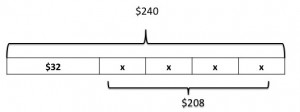People sometimes feel compelled to tell me how much they hate math. When I ask when this started, many point to algebra (the rest say fractions, but we can talk about that another day).
We know that many students struggle when they get to algebra. Researchers have been studying how to ease this transition through “early algebra.” They found that simply introducing traditional algebra concepts at an early age isn’t the answer.
Instead, Blanton & Kaput (2005) talk about “algebrafying” the elementary school curriculum, in which elementary school concepts are developed in a way that allows generalizations about properties and relationships to become more explicit. For example, students are asked to identify and generalize about patterns, relationships and structure in mathematics. They are given tasks that require them to reason about unknown quantities. At early ages, they develop the ability to identify, describe and analyze how quantities vary in relation to each other.
As you may have noticed, I’ve been obsessed with tape diagrams recently. In fact, I’m doing a Global Math Department session about them tomorrow night if you want to hear more. One of the benefits I haven’t talked about yet is their potential for developing algebraic thinking.
Take a look at this problem.
Nicora wants to buy herself a new bicycle that costs $240. She has already saved $32, but needs to make a plan so she can save the rest of the money she needs. She decides to save the same amount of money each month for the next four months. How much money must she save each month to meet her monthly goal of buying a bicycle?
Many of you probably solved it by setting up the equation $240= $32+ 4x and solving for x.
However, younger students could also solve it by setting up a tape diagram like the one below.
After creating the diagram and using it to solve the problem, students can talk about writing a number sentence to represent the situation. This allows the to give meaning to each part of the equation. Students can discuss what the $240 represents, what $32 represents and what the missing number, x, represents. They can also discuss how they solved for the missing number. In this way, the tape diagram can be used to build developing algebraic thinking.
Want to know more?
Blanton, M., & Kaput, J. (2005). Characterizing a classroom practice that promotes algebraic reasoning. Journal for Research in Mathematics Education, 412-446.

Brilliant timing-thank you! I have learned so much already from your posts and was preparing to share tape diagram applications today with our middle/high school group. This provides a great link between elementary practice and success in high school and beyond.
Thanks Maureen! I’d love to hear what the high school teachers think.
Nicora,
Funny that it’s either fractions or algebra that makes math taste like vinegar to most people.
Many could say that the gateway to algebra is fractions when in fact it could even go back to whole numbers. Procedural knowledge has eclipsed conceptual understanding of whole and fractional numbers for far too long in elementary school. My hope is that CCSS continues to push for the algebrafication of concepts.
I’m really looking forward to your session tomorrow because the understanding of the tape diagram can even be made sense of in kindergarten. I’ve been pushing some primary people to join tomorrow’s session but we’ll see. Part-whole thinking is the same whether its kindergarten through 12th grade, whole numbers through algebra, and everything in between!
Good luck tomorrow and thanks for sharing your wisdom!
Graham
Thanks Graham. I agree with you that the conceptual piece has been missing in too many elementary classes and that leads to people hating fractions and algebra! I’m excited to hear what you think of the session. And please push the elementary people to join in. It’s nice for teachers of the younger grades to see how important the work they do becomes later on. Sometimes we get wrapped up in our own grades that we lose sight of the big picture and how things progress from year to year.
Pingback: Solving Equations (Day 1) | When Math Happens